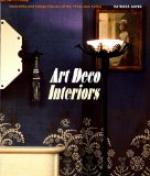For a woman’s bathroom, Venetian glass bottles, covered jars and bowls of every size, come in opalescent pale greens and other delicate tints. See Plate XI. Then there are the white glass bottles, jars, bowls, and trays with bunches of dashing pink roses, to be obtained at any good department store. Glass toilet articles come in considerable variety and at all prices, and to match any colour scheme; so use them as notes of colour on the glass shelves in your bathrooms. Here, too, is an opportunity to use your old Bristol or Bohemian glass, once regarded as inherited eyesores, but now unearthed, and which, when used to contribute to a colour scheme, have a distinct value and real beauty.
PLATE XVI
Part of a room in a small suite where the furniture is all old and the majority of it Empire in style. However, the small piano at once declares itself American Empire. The beautifully decorative nameplate on its front reads, “Geib & Walker, 23 Maiden Lane, N.Y.” The date of piano is about 1830.
The brown mahogany commode on the right has the lion’s claw-feet, and pilasters are topped by women’s heads in bronze. This piece was bought in France. It has the original marble top, dark pink veined with white. The knobs on drawers are bronze lions’ heads, holding rings in their mouths. Chairs are Italian and between Directoire and Empire.
The table, a good specimen, was also found in France. On the table is a French vanity mirror, Louis XVI in time, very Greek in design. The mirror is on both sides and turns on a gold arrow which pierces it. The bronze frame of mirror has a design so intricate in detail that it resembles lace work.
The vase on the piano is Empire
and antique, decoration of green
and gold. The flowers
on table are artificial, a quaint Victorian
contrast.
Through the doorway one sees the end of an Empire bed which came from an old chateau in Brittany. Note the same pilasters as on bureau, only that in this case the woman’s head is gilded wood and two little feet of gilded wood appear at base of mahogany pilaster.
A gilded urn rests on a mahogany
post of bed against the wall, the
only position possible for
beds of this style. The head and foot
board are of equal height
and alike.
Few Empire beds are now on the market. This one is used with a roll at each end and is covered with genuine Empire satin in six-inch stripes of canary yellow and sage green divided by two narrow black stripes and a narrow white stripe between them.
[Illustration: Corner of a Room in a Small Empire Suite]
To-day a bathroom is considered the necessary supplement to every bedroom in an apartment or house, where the space allows, and no house is regarded as a good investment if built with less than one bath to communicate with every two rooms. Yet among the advertisements in the New York City Directory of 1828 we read the following naive statement concerning warm baths, which is meant in all seriousness. It refers to the “Arcade Bath” at 32 Chambers Street, New York City.




